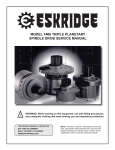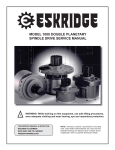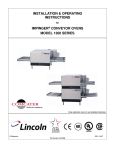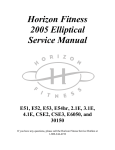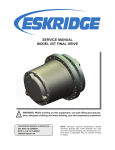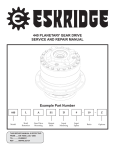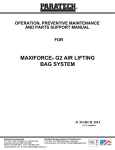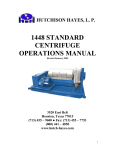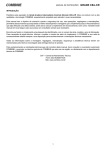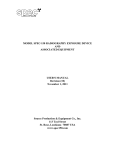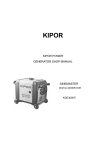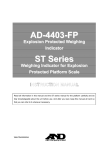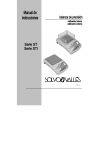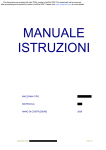Download SERVICE MANUAL L130B / L4130 Series
Transcript
SERVICE MANUAL L130B / L4130 Series Logstacker Drive Axle With Bolt-On Stub End Retainer Page 1 Allied Form #80-930 Rev 07/2009 SERVICE MANUAL LOG STACKER DA202 DRIVE AXLE TABLE OF CONTENTS PROCEDURE FOR WHEEL END DISASSEMBLY AND REASSEMBLY – AXLE HOUSING NOT REMOVED FROM STACKER A. DISASSEMBLY OF WHEEL END – AXLE HOUSING HAS NOT BEEN REMOVED FROM STACKER……………..3 B. REASSEMBLY OF WHEEL END – AXLE HOUSING HAS NOT BEEN REMOVED FROM STACKER……………...4 C. INSTALLATION OF DUO-CONE FACE SEAL……………………………………………………………………………….6 D. INSTALLATION OF TORQUE TUBE AND BRAKE DISC…………………………………………………………………..8 E. INSTALLATION OF WHEEL…………………………………………………………………………………………………….8 PROCEDURE FOR WHEEL BEARING SERVICE AND ADJUSTMENT WITH BOLTED RETAINER PLATE AND SHIM PACK – AXLE HOUSING NOT REMOVED FROM STACKER A. ADJUSTING WHEEL BEARINGS WHEN WHEELS HAVE BEEN REMOVED………………………………………....10 B. ADJUSTING WHEEL BEARINGS WHEN WHEELS HAVE NOT BEEN REMOVED……………………………….…..14 PROCEDURE FOR WHEEL END DISASSEMBLY AND REASSEMBLY – AXLE HOUSING REMOVED FROM STACKER A. DISASSEMBLY OF WHEEL END – AXLE HOUSING REMOVED FROM STACKER………………………………....19 B. REASSEMBLY OF WHEEL END – AXLE HOUSING REMOVED FROM STACKER…………………………...…......20 C. INSTALLATION OF DUO-CONE FACE SEAL……………………………………………………………………………....21 D. INSTALLATION OF TORQUE TUBE AND BRAKE DISC……………………………………………………………...…..23 E. INSTALLATION OF WHEEL……………………………………………………………………………………………...…....24 PROCEDURE FOR WHEEL BEARING SERVICE AND ADJUSTMENT WITH BOLTED RETAINER PLATE AND SHIM PACK A. ADJUSTING WHEEL BEARINGS – WITH AXLE HOUSING REMOVED FROM STACKER…………………………...26 2 7/16/2009 STACKER AXLE PROCEDURE FOR WHEEL END DISASSEMBLY AND REASSEMBLY Internal Gear Hub Wheel Torque Tube Bolt Shim Set Stub End Adapter-Seal Plate Retainer Cup & Cone Outer Bearing Cup & Cone Inner Bearing Duo-Cone Seal Axle Housing O-Ring Brake Caliper Disc Brake FIGURE 1 A. Wheel End Disassembly- Axle Housing-Outer End Has Not Been Removed From Stacker. 1. Unit should be on level ground. 2. Block in front and behind wheel that is opposite the side to be worked on. 3. Using adequate jack, raise wheel off of ground and crib unit at axle housing. 4. Tires and rims must always be removed before attempting to adjust wheel bearings or before removing the wheel. CAUTION: Always completely deflate both tires prior to removing any rim clamps or loosening lug nuts. Always check the valve stem to make sure air passage is clear and tires are completely deflated prior to disassembly of rims from wheel. Run a piece of wire through the valve stem to make sure it is not plugged. Foreign material may clog the valve stem during deflation or ice may form. 3 7/16/2009 STACKER AXLE PROCEDURE FOR WHEEL END DISASSEMBLY AND REASSEMBLY 5. Remove rims with tires. 6. Remove (3) disc brake calipers. 7 Drain oil from planet assembly. 8. Remove planet carrier cover. 9. Remove 2nd stage planet assembly. 10. Remove 1st stage planet assembly. 11. Remove axle shaft and sun gear as an assembly. 12. Block up under wheel to support it or attach a lifting device to wheel through slot in OD of wheel. (Lift device must be able to lift 4,000 lbs.) 13. Remove ¾” bolts, retainer plate and shims. 14. For easier internal gear assembly, removal and installation install Guide Thimble 070-284 onto outer end of stub end using bolts in threaded holes on the end of stub end. 15. Slide internal gear assembly and outer bearing out of wheel and onto guide tool. Using a forklift or boom truck, remove internal gear assembly and bearing. 16. With lifting device that is attached to wheel assembly remove wheel from stub end. (Weight is approximately 4,000 lbs.) Set assembly on the ground with torque tube and brake disc up. 17. Remove brake disc, (2) half discs. 18. Remove torque tube. 19. Inspect all parts and replace as necessary. B. Wheel End Reassembly – Axle Housing – Outer End Has Not Been Removed From Stacker 1. Check unit to make sure it is cribbed properly, preferably in two places. 2. All parts should be cleaned and all oil, grease and rust removed prior to assembly. Clean the inside of the wheel and bearing bores of chips and accumulated dirt that may be trapped in the bearing cavity. It is very important that this area be free of foreign material. 4 7/16/2009 STACKER AXLE PROCEDURE FOR WHEEL END DISASSEMBLY AND REASSEMBLY 3. Inspect the axle stub end and internal gear hub for nicks or burrs; remove as needed. Inspect drilled and tapped holes for metallic chips. Blow out drilled holes, if necessary, to ensure cleanliness. 4. Inspect the Duo-Cone seal retainer and bearing spacer located on the stub end and replace if required. To install seal retainer, clean stub end surface and inner surface of seal retainer with Loctite Cleaner #7070. Coat inside surface of retainer ring with Locktite #7649 Primer N. Let dry for 30 seconds. Place retainer in rod oven and heat to 100 degrees. Check with heat gun to verify 100 degrees. Apply a light coat of Locktite 620 Retaining Compound on the stub end surface for 1/3 the width of the retainer and only on the leading edge from where the retainer will be positioned when fully in place. Use only a light coat and only at the leading edge. When installing the retainer the Locktite will wick under the retainer. If too much Locktite is applied the retainer will push too much of it back to where it will interfere with the retainer seating against the shoulder. 5. Inspect the inner and outer wheel bearing bores and seal bore for nicks and burrs; remove as required. Chill cups in dry ice for 15 minutes or in a freezer. CAUTION: Do not allow bearings to chill below -40 Fahrenheit. At -65o Fahrenheit the metallurgical characteristics of the bearing material will be altered. o 6. Install the chilled inner and outer bearing cups in the wheel into the bearing cup bores. After the temperatures have stabilized ensure that cups are fully seated by checking a minimum of three places between bearing cups and backing shoulder with a .001” or .0015” feeler gauge. Seat, if necessary, with soft bar and hammer. 7. Heat the outer and inner wheel bearing cones to 250o F (in hot oil or in an induction oven). Do not use a torch for heating bearings. Install the outer bearing cone on the internal gear hub and install the inner bearing cone on the stub end. After the bearing cones are cooled ensure that they are fully seated by checking a minimum of three places between bearing and backing shoulder on internal gear hub and on stub end with a .001” or .0015” feeler gauge. If not seated, use a soft bar and hammer to seat them. 8. With both inner and outer bearing cones installed prelube the bearings with Lubriplate 3000W lubricant. 9. Proceed with installation of Duo-Cone face seal. See (Section C, PAGE 6). 5 7/16/2009 STACKER AXLE PROCEDURE FOR WHEEL END DISASSEMBY AND REASSEMBLY C. Installation of Duo-Cone Face Seal 1. Face ring (Duo-Cone) seals have highly finished surfaces and are held together by toric sealing rings. The flexibility of the toric sealing rings makes the floating ring seals self aligning and compensates for wear on the metal faces. 2. Install seals with care to not damage them in handling and on installation. Always install the metal Duo-Cone rings in matched pairs; that is, two new rings together or two rings that have previously run together. When installing new seals do not intermix the metal rings as they are match ground in pairs. 3. Remove all oil or protective coating from Duo-Cone metal rings and from the ramps on the wheel, and on the seal retainer and dry them. Use one of the approved assembly lubricants (listed at the end of this section) as a cleaning agent. Do not use any other liquid that leaves an oily film or does not evaporate quickly. 4. Be sure the ramps on the wheel, and retainer are dry and that no oil is present. Check the ramps for rough marks and nicks. On used parts, remove all dirt or rust deposits from the ramps with a scraper or wire brush and smooth the surface with emery cloth. 5. Always install new toric sealing rings. Never install a used toric sealing ring on a new or used DuoCone seal. 6. Install torics onto Duo-Cone metal rings. The toric must rest uniformly against the retaining lip and the flashing line of the toric must be straight and parallel (not twisted) with the retaining lip. 7. Use seal installation tool 075-007 to install one half of the Duo-Cone seal assembly into seal ramp on wheel. Wet the lower half of the toric in approved lubricant by dipping or brushing on with a clean foam brush, or wiping on with a lint free cloth. See Figure 2. FIGURE 2 6 7/16/2009 STACKER AXLE PROCEDURE FOR WHEEL END DISASSEMBY AND REASSEMBLY While still wet, quickly press seal assembly into the wheel with the seal installation tool. Seating the seal into wheel may require tapping on the tool lightly with a rubber mallet. Be careful to not twist the toric. On large seals it may require starting on one side and tapping on the opposite side of tool to push seal assembly into place until the toric is engaged past the retaining lip of the seal ramp on the wheel. Measure from seal face of wheel to the seal face surface in four places 90 degrees apart to make sure the seal is correctly installed (must be parallel). See Figure 3. “A” Dimension. Height variation around the assembled ring should not exceed .040”. Use the seal installation tool to make any adjustments. Do not push directly on the metal seal ring. 8. Repeating the basic procedure as outlined in item No. C.7, use seal installation tool 075-007 to install one half of the Duo-Cone seal assembly onto the seal retainer located on the axle stub end. 9. Before assembling the wheel to the stacker axle, wipe the faces of the seal with a lint free cloth to remove any foreign material. Put a thin film of clean oil on the seal faces. Be careful to not let any oil come in contact with the toric or its mating surface. FIGURE 3 Approved Assembly Lubricants Isopropyl Alcohol* Houghto-Grind 60 CT Quaker Solvo Clean 68*All applicable safety and disposal guidelines for flammable liquids must be followed. 7 7/16/2009 STACKER AXLE PROCEDURE FOR WHEEL END DISASSEMBLY AND REASSEMBLY D. Installation Of Torque Tube and Brake Disc 1. Clean mating surfaces of wheel and torque tube of all paint, burrs, etc., to ensure torque tube has full contact. 2. Turn wheel upside down with planet adapter towards bottom. 3. Position torque tube over wheel and align all bolt holes while lowering tube to wheel. 4. Install bolts with anti-seize compound and torque in criss-cross pattern to 680 ft. lbs. (+68/-0). 5. Install first half of brake disc. 6. Install bolts and washers using Locktite #242 and torque to 280 ft. lbs.(+28/-0). 7. Install second half of brake disc and repeat bolt installation process. 8. Do not mount the brake calipers until after the wheel has been installed and wheel bearing adjustment has been completed. E. Wheel Installation 1. Make sure unit is safely cribbed. 2. The wheel, torque tube and disc brake assembly may be carried by forklift or by sling and overhead crane during installation. It is suggested that Guide Thimble, 070-284 bolted onto the end of the stub end be used to aid in alignment of the wheel on stub end during wheel mounting. Lift wheel, torque tube and disc brake assembly and slide it over the stub end until the inner bearing seats on the stub end. CAUTION: When installing the heavy wheel, torque tube and brake disc on the stub end use extreme care to ensure that the wheel is maintained in a level position and centered in relation to the axle. Failure to do so may result in damage to a seal. CAUTION: Do not bang wheel into place on the stub end. This can damage the seal. 8 7/16/2009 STACKER AXLE PROCEDURE FOR WHEEL END DISASSEMBLY AND REASSMBLY 3. With the wheel still supported in a level position, use overhead crane to lift and align the internal gear assembly and outer bearing cone previously installed as instructed in Section B, Item 7 (PAGE 5). Install the internal gear assembly with outer bearing cone using guide tool and slide all the way onto stub end until bearing engages. Lubricant on the stub end will ease installation of the internal gear hub. 4. Install retainer plate without shims using two retainer plate bolts, (3/4-10UNC), spaced 180o apart and next to the measurement holes. See FIGURE 4 (PAGE 10). Tighten the bolts until retainer plate is snug against internal gear hub and looseness is taken out of the bearings but the bolts are not tight. 5. Remove sling and overhead crane or support from underneath the wheel. Bolts and retainer plate will keep wheel from sliding off stub end. Removing support will allow bearing rollers to be properly aligned while the wheel is being rotated. 6. Adjust wheel bearings and complete final installation of the retainer plate per “Wheel Bearing Adjustment Procedure.” See (PAGE 10). Note: After wheel bearing adjustment is completed, continue with wheel installation. 7. Install axle shaft and sun gear as an assembly. 8. Pre-lube internal gear with Lubriplate 3000-W and install 1st stage planet. Remove the 7/8” sun gear retaining bolt. Insert a bar into the open bolt hole in the axle shaft and lift the axle and the sun gear for aligning the gear teeth of the sun gear, 1st stage planet and internal gear at the same time. 9. Install 2nd stage planet assembly and O-ring. 10. Install 2nd stage housing bolts and torque to 280 ft. lbs. (+28/-0). 11. Reinstall 7/8” sun gear retaining bolt previously removed in Step #8. 12. Install planet carrier cover and sun gear cover plate. 13. Mount the (3) brake calipers. 14. Mount tires and rims. 15. Fill wheel to oil level with recommended lubricant. 9 7/16/2009 STACKER AXLE WHEEL BEARING SERVICE AND ADJUSTMENT WITH BOLTED RETAINER PLATE AND SHIM PACK A. Procedure for Bearing Adjustment When Wheels Have Been Removed. 1. Install wheel assembly with bearing cups, torque tube and brake disc onto stub end, following instructions in “Wheel End Re-assembly”. 2. With wheel assembly positioned on stub end while being supported on the underneath outer edge, install wheel bearing retainer plate without shims, using two retainer plate bolts, (3/4-10UNC), spaced 180o apart and next to the measurement holes. See (Figure 4). Do not lube the bolt threads, install the bolts clean and dry. All threads in the stub end should be clean and dry. Tighten the bolts until retainer plate is snug against internal gear hub and looseness is taken out of the bearings but the bolts are not tight. 3. Remove support from underneath the wheel. Bolts and retainer plate will keep wheel from sliding off stub end. Removing the support will allow bearing rollers to be properly aligned while the wheel is being rotated. Roll the wheel 3 to 5 revolutions. FIGURE 4 10 7/16/2009 STACKER AXLE WHEEL BEARING SERVICE AND ADJUSTMENT WITH BOLTED RETAINER PLATE AND SHIM PACK Internal Gear Hub FIGURE 5 Note: It is very important to rotate the wheel while tightening the bearing retainer bolts. Failure to rotate wheels could result in a bearing cone that has not seated in the cup, thus resulting in improperly adjusted bearings. The wheel must be rotated a minimum of three revolutions to ensure that all bearing rollers are aligned and seated properly. 4. While rotating wheel, initially torque the two retainer plate bolts to 150 ft. lbs. in 25 ft. lb. increments. 5. Back out the two bolts to zero ft. lbs. followed by rotating the wheel to completely release all load on the bearings. Be sure the internal gear hub and the outboard bearing slide back out to release all load on the bearings. 6. Now torque the two retainer plate bolts to 60 ft. lbs. in 20 ft. lb. increments while rotating the wheel or followed by wheel rotation after each torquing step. Continue the sequence of rotating the wheel followed by carefully retorquing to 60 ft. lbs. Do this until the two bolts no longer advance when retorqued to the specified 60 ft. lbs. 11 7/16/2009 STACKER AXLE WHEEL BEARING SERVICE AND ADJUSTMENT WITH BOLTED RETAINER PLATE AND SHIM PACK Note: It is very important to rotate the wheel while tightening the retainer bolts. Failure to rotate wheels could result in a bearing cone that has not seated in the cup, thus resulting in improperly adjusted bearings. The wheel must be rotated a minimum of three revolutions to ensure that all bearing rollers are aligned and seated properly. 7. Using a depth micrometer, measure the total distance from the outer surface of the retainer plate to the spindle end, through each of the two retainer plate measurement holes and average the two measurements and record. See (Figure 4. PAGE 10 and Figure 5, PAGE 11). 8. Place support under the outer edge of the wheel assembly or hang by sling and overhead crane. 9. Loosen the retainer plate slowly until bolts can be removed by hand. Remove the retainer plate with care, as the internal gear hub, outer bearing and wheel may want to slide off of the stub end. 10. Measure the retainer plate thickness in four places and average the readings. Subtract the retainer plate thickness from the average of the total distance measured and recorded in Step 7. The subtracted dimension is the required shim pack thickness to properly adjust and preload the wheel bearings. Do not add or subtract shims from this dimension. Carefully following this adjustment procedure and correctly selecting the correct shim pack thickness as instructed will result in the correct .004 to .005 bearing preload. Note: This adjustment procedure and preload values are the same for new and used bearings. 11. Re-install retainer plate with the properly adjusted shim pack between stub end and retainer plate. Tighten two bolts with dry, clean threads until retainer plate is snug against wheel assembly. Doing this will prevent Loctite to be used later from running into shim pack and creating possible interference. 12. Remove support from under outer edge of wheel assembly or from sling and overhead crane. 12 7/16/2009 STACKER AXLE WHEEL BEARING SERVICE AND ADJUSTMENT WITH BOLTED RETAINER PLATE AND SHIM PACK 13. Before applying Loctite be sure that bolt threads and threaded holes are clean and dry. Clean them using brake cleaner solvent. Blow bolt threads and threaded holes dry using compressed air. Apply Loctite #262 to all additional bolts. Initially torque to 120 ft. lbs. using torque sequence shown in (Figure 6, PAGE 13). Next be sure to remove original two bolts and clean bolt threads and threaded holes. Apply Loctite to the original bolts as well. Remember to rotate wheel to align rollers in bearings as bolts are torqued. Now continue torquing all bolts in 40 ft. lbs. increments to final 280 ft. lbs. (+28/-0) using torque sequence shown. Retorque until bolts no longer move at specified torque. Note: Work rapidly without delay as depending on temperature conditions. Locktite may set up quickly and affect torque reading. Final torque of all bolts should be completed in 10 minutes. 14. As final check on bearing adjustment check the bottom rollers of the bearing by reaching through the small inspection hole in the internal gear trunion. With a medium length screwdriver, (don’t use a heavy pry bar) check that the bottom rollers do not move side to side without applying heavy pressure on the rollers. 15. If rollers are easily moved, re-adjust bearings by removing additional shims to tighten roller movement side to side. If bearing adjustment is too tight, readjust by adding shims to loosen the adjustment. The over-tight condition can be judged by bearings so tight that you are unable to rotate the wheel with your full body weight when stepping/climbing on the wheel casting cutouts. Note: After wheel bearing adjustment is completed, continue with wheel installation. See (Section E, Items 7 to 15, Page 9). FIGURE 6 13 7/16/2009 STACKER AXLE WHEEL BEARING SERVICE AND ADJUSTMENT WITH BOLTED RETAINER PLATE AND SHIM PACK B. Procedure for Checking and Adjusting Wheel Bearings When Wheels Have Not Been Removed . 1. Stacker should be on level ground with wheels chocked in front and behind wheel that is opposite the side to be worked on. 2. Using adequate jack, raise stacker wheel off ground and crib under stacker axle housing. CAUTION: Tires and rims must always be removed before attempting to adjust wheel bearings. Always completely deflate both tires prior to removing any rim clamps or loosening lug nuts. Always check the valve stem to make sure air passage is clear and tires are completely deflated prior to disassembly of rims from wheels. Run a piece of wire through the valve stem to make sue it is not plugged. Foreign material may clog the valve stem during deflation or ice may form. 3. Remove rims with tires. 4. Remove the (3) disc brake calipers or back off all caliper pistons to eliminate any possibility of brake drag. 5. Drain oil from planet assembly. 6. Remove planet carrier cover. 7. Remove 2nd stage planet assembly. 8. Remove 1st stage planet assembly. 9. Remove axle shaft with sun gear as an assembly. 10. With the wheel raised and no support under it check the bottom rollers of the outboard bearing cone by reaching through the small inspection hole in the internal gear trunnion. With a small screwdriver (don’t use a heavy pry bar) check that the bottom rollers do not move side to side without applying heavy pressure on the rollers. 14 7/16/2009 STACKER AXLE WHEEL BEARING SERVICE AND ADJUSTMENT WITH BOLTED RETAINER PLATE AND SHIM PACK 11. If the rollers are tight under pressure from the screwdriver an adjustment is not required. Proceed with replacing all removed parts. 12. If rollers are loose, proceed with Step 13 through 29. 13 Block up under outer end of stacker wheel for support or use sling and overhead crane. (Lift device must be able to lift 4,000 lbs). 14. Remove 3/4” bolts from retainer plate. Loosen the retainer plate slowly until bolts can be removed by hand. Remove the retainer pate with care, as the internal gear hub, outer bearing and wheel may want to slide off of the stub end. 15. Remove all shims. Set shims aside for re-use. 16. Thoroughly clean all Loctite from bolt threads using wire brush. Run tap into threaded holes in stub end and wash out with brake cleaning solvent and compressed air. 17. With wheel assembly being supported underneath the outer edge, install retainer plate without shims using two retainer plate bolts (3/4-10UNC) spaced 180o apart and next to the two measurement holes. See (Figure 7). Do not lube the bolt threads, install the bolts clean and dry. All threads in the stub end must be clean and dry. Tighten the bolts until retainer plate is snug against internal gear hub and looseness is taken out of the bearings but the bolts are not tight. FIGURE 7 15 7/16/2009 STACKER AXLE WHEEL BEARING SERVICE AND ADJUSTMENT WITH BOLTED RETAINER PLATE AND SHIM PACK Internal Gear Hub FIGURE 8 18. Remove support from underneath the wheel. Bolts and retainer plate will keep wheel from sliding off stub end. Removing the support will allow bearing rollers to be properly aligned while the wheel is being rotated. Roll the wheel 3 to 5 revolutions. Note: It is very important to rotate the wheel while tightening the bearing retainer bolts. Brakes must not be dragging during wheel rotation. Refer to Section B, item 4. Failure to rotate wheels could result in improperly adjusted bearings. 19. While rotating wheel, initially torque the two retainer plate bolts to 150 ft. lbs. in 25 ft. lb. increments. 20. Back out the two bolts to zero ft. lbs., followed by rotating the wheel to completely release all load on the bearings. Be sure the internal gear hub and the outboard bearing slide back out to release all load on the bearings. 16 7/16/2009 STACKER AXLE WHEEL BEARING SERVICE AND ADJUSTMENT WITH BOLTED RETAINER PLATE AND SHIM PACK 21. Now torque the two retainer plate bolts to 60 ft. lbs. in 20 ft. lb. increments while rotating the wheel or followed by wheel rotation after each torquing step. Continue the sequence of rotating the wheel followed by carefully retorquing to 60 ft. lbs. Do this until the two bolts no longer advance when retorqued to the specified 60 ft. lbs. Note: It is very important to rotate the wheel while tightening the retainer bolts. Failure to rotate wheels could result in a bearing cone that has not seated in the cup, thus resulting in improperly adjusted bearings. The wheel must be rotated a minimum of three revolutions to ensure that all bearing rollers are aligned and seated properly. 22. Using a depth micrometer, measure the total distance from the outer surface of the retainer plate to the spindle end, through each of the two retainer plate measurement holes and average the two measurements and record. See (Figure 7, PAGE 15 and Figure 8, PAGE 16). 23. Place support under the outer edge of the wheel assembly or hang by sling and overhead crane. 24. Loosen the retainer plate slowly until bolts can be removed by hand. Remove the retainer plate with care, as the internal gear hub, outer bearing and wheel may want to slide off of the stub end. 25. Measure the retainer plate thickness in four places and average the readings. Subtract the retainer plate thickness from the average of the total distance measured and recorded in Step 22. The subtracted dimension is the required shim pack thickness to properly adjust and preload the wheel bearings. Do not add or subtract shims from this dimension. Carefully following this adjustment procedure and correctly selecting the correct shim pack thickness as instructed will result in the correct .004 to .005 bearing preload. Note: This adjustment procedure and preload values are the same for new and used bearings. 26. Re-install retainer plate with the properly adjusted shim pack between stub end and retainer plate. Tighten two bolts with dry, clean threads until retainer plate is snug against wheel assembly. Doing this will prevent Loctite to be used later from running into shim pack and creating possible interference. 17 7/16/2009 STACKER AXLE WHEEL BEARING SERVICE AND ADJUSTMENT WITH BOLTED RETAINER PLATE AND SHIM PACK 27. Remove support from under outer edge of wheel assembly or from sling and overhead crane. Before applying Loctite by sure that bolt threads and threaded holes are clean and dry. Clean them using brake cleaner solvent. Blow bolt threads and threaded holes dry using compressed air. Apply Loctite #262 to all additional bolts. Initially torque to 120 ft. lbs. using torque sequence shown in (Figure 9). Next be sure to remove original two bolts and clean bolt threads and threaded holes. Apply Loctite to the original bolts as well. Remember to rotate wheel to align rollers in bearings as bolts are torqued. Now continue torquing all bolts in 40 ft. lb. increments to final 280 ft. lbs. (+28/-0) using torque sequence shown. (See Figure 9). Retorque until bolts no longer advance at specified torque. Note: Work rapidly without delay as depending on temperature conditions, Locktite may set up quickly and affect torque reading. Final torque of all bolts should be completed in 10 minutes. 28. As final check on bearing adjustment, check the bottom rollers of the bearing by reaching through the small inspection hole in the internal gear trunnion. With a medium length screwdriver, (don’t use a heavy pry bar) check that the bottom rollers do not move side to side without applying heavy pressure on the rollers. FIGURE 9 29. If rollers are easily moved, re-adjust bearings by removing additional shims to tighten roller movement side to side. If bearing adjustment is too tight, readjust by adding shims to loosen the adjustment. The over-tight condition can be judged by bearings so tight that you are unable to rotate the wheel with your full body weight when stepping/climbing on the wheel casting cutouts. Note: After wheel bearing adjustment is completed, continue with wheel installation. See (Section E, items 7 to 15, Page 9). 18 7/16/2009 STACKER AXLE PROCEDURE FOR WHEEL END DISASSEMBLY AND REASSEMBLY WITH AXLE HOUSING REMOVED FROM STACKER A. Wheel End Disassembly-With Axle Housing-Outer End Removed From Stacker. 1. Unit should be on level ground. 2. Block in front and behind wheel that is opposite the side to be worked on. 3. Using adequate jack, raise wheel off of ground and crib unit inboard of Axle Housing-Outer End. CAUTION: Always completely deflate both tires prior to removing any rim clamps or loosening lug nuts. Always check the valve stem to make sure air passage is clear and tires are completely deflated prior to disassembly of rims from wheel. Run a piece of wire through the valve stem to make sure it is not plugged. Foreign material may clog the valve stem during deflation or ice may form. 4. Remove rims with tires. 5. Remove (3) disc brake calipers. 6. Drain lube from wheel. 7. Remove cover plate-sun gear and cover-planet carrier. 8. Remove (1) 7/8” bolt and (4) 1/2 “ bolts from sun gear retainer and remove sun gear retainer. 9. Remove axle shaft by pulling the shaft through the sun gear hub leaving the sun gear in place. 10. Using overhead crane for support and for lifting, remove axle housing outer end and wheel from stacker frame. (Lift device must be able to lift 8,000 to 10,000 lbs.) 11. Position axle housing and wheel in vertical position with axle housing base end down and wheel up. 12. Using overhead crane remove 2nd stage planet assembly. 13. Remove 1st stage planet assembly. 19 7/16/2009 STACKER AXLE PROCEDURE FOR WHEEL END DISASSEMBLY AND REASSEMBLY WITH AXLE HOUSING REMOVED FROM STACKER 14. Remove 3/4 bolts, retainer plate and shims. 15. Using overhead crane, remove internal gear assembly along with outer bearing cone. 16. With lifting device attached to wheel assembly remove wheel from stub end. (Weight is approximately 4,000 lbs.) Set wheel assembly on the ground with torque tube and brake disc up. 17. Remove brake disc, (2) half discs. 18. Remove torque tube. 19. Inspect all parts and replace as necessary. B. Wheel End Reassembly With Axle Housing Outer End Removed From Stacker. 1. All parts should be cleaned and all oil, grease and rust removed prior to assembly. Clean the inside of the wheel and bearing bores of chips and accumulated dirt that my be trapped in the bearing cavity. It is very important that this area be free of foreign material. 2. Position axle housing-outer end with base on floor, stub end up. 3. Inspect the axle stub end and internal gear hub for nicks or burrs; remove as needed. Inspect drilled and tapped holes for metallic chips. Blow out drilled holes, if necessary, to ensure cleanliness. 4. Inspect the Duo-Cone seal retainer and bearing spacer on the stub end and replace if required. To install seal retainer, clean stub end surface and inner surface of seal retainer with Loctite Cleaner #7070. Coat inside surface of retainer ring with Loctite #7649 Primer N. Let dry for 30 seconds. Place in rod oven and heat to 100oF. Check with heat gun to verify 100o. Apply a light coat of Locktite 620 retaining compound on the stub end surface for 1/3 the width of the retainer and only on the leading edge from where the retainer will be positioned when fully in place. Use only a light coat and only at the leading edge. When installing the retainer the Loctite will wick under the retainer. If too much Locktite is applied the retainer will push it back to where it will interfere with the retainer seating against the shoulder. 20 7/16/2009 STACKER AXLE PROCEDURE FOR WHEEL END DISASSEMBLY AND REASSEMBLY WITH AXLE HOUSING REMOVED FROM STACKER 5. Inspect the inner and outer wheel bearing bores and seal bore for nicks and burrs: remove as required. Chill cups in dry ice for 15 minutes or in a freezer. CAUTION: Do not allow bearings to chill below -40oF. At –65oF the metallurgical characteristics of the bearing material will be altered. 6. Install the chilled inner and outer bearing cups in the wheel into the bearing cup bores. After the temperatures have stabilized ensure that cups are fully seated by checking a minimum of three places between bearing cups and backing shoulder with a .001” or .0015” feeler gauge. Seat, if necessary, with soft bar and hammer. 7. Heat the outer and inner wheel bearing cones to 250oF (in hot oil or in an induction oven). Do not use a torch for heating bearings. Install the outer bearing cone on the internal gear hub and install the inner bearing cone on the stub end. After the bearing cones are cooled ensure that they are fully seated by checking a minimum of three places between bearing and backing shoulder on internal gear hub and on stub end with a .001” or .0015” feeler gauge. If not seated, use a soft bar and hammer to seat them. 8. With both inner and outer bearing cones installed prelube the bearings with Lubriplate 3000W. lubricant. 9. Proceed with installation of Duo-cone face seal. C. Installation of Duo-Cone Face Seal 1. Face ring (Duo-Cone) seals have highly finished surfaces and are held together by toric sealing rings. The flexibility of the toric sealing rings makes the floating ring seals self aligning and compensates for wear on the metal faces. 2. Install seals with care to not damage them in handling and on installation. Always install the metal Duo-Cone rings in matched pairs; that is, two new rings together or two rings that have previously run together. When installing new seals do not intermix the metal rings as they are match ground in pairs. 3. Remove all oil or protective coating from Duo-Cone metal rings and from the ramps on the wheel and on the seal retainer and dry them. Use one of the approved assembly lubricants (listed at the end of this section) as a cleaning agent. Do not use any other liquid that leaves an oily film or does not evaporate quickly. 21 7/16/2009 STACKER AXLE PROCEDURE FOR WHEEL END DISASSEMBLY AND REASSEMBLY WITH AXLE HOUSING REMOVED FROM STACKER 4. Be sure the ramps on the wheel and retainer are dry and that no oil is present. Check the ramps for rough marks and nicks. On used parts, remove all dirt or rust deposits from the ramps with a scraper or wire brush and smooth the surface with emery cloth. 5. Always install new toric sealing rings. Never install a used toric sealing ring on a new or used Duo-Cone seal. 6. Install torics onto Duo-Cone metal rings. The toric must rest uniformly against the retaining lip and the flashing line of the toric must be straight and parallel (not twisted) with the retaining lip. 7. Use seal installation tool 075-007 to install one half of the Duo-Cone seal assembly into seal ramp on wheel. Wet the lower half of the toric in approved lubricant by dipping or brushing on with a clean foam brush or wiping on with a lint free cloth. See Figure 10. Figure 10 While still wet, quickly press seal assembly into the wheel with the seal installation tool. Seating the seal into wheel may require tapping on the tool lightly with a rubber mallet. Be careful to not twist the toric. On large seals it may require starting on one side and tapping on the opposite side of tool to push seal assembly into place until the toric is engaged past the retaining lip of the seal ramp on the wheel. Measure from seal face of wheel to the seal face surface in four places 90o apart to make sure the seal is correctly installed (must be parallel). See Figure 11, “A” Dimension. Height variation around the assembled ring should not exceed .040.” Use the seal installation tool to make any adjustments. Do not push directly on the metal seal ring.. Figure 11 22 7/16/2009 STACKER AXLE PROCEDURE FOR WHEEL END DISASSEMBLY AND REASSEMBLY WITH AXLE HOUSING REMOVED FROM STACKER 8. Repeating the basic procedure as outlined in item No. C. 7, use seal installation tool 075-007 to install one half of the Duo-Cone seal assembly onto the seal retainer located on the axle stub end. 9. Before assembling the wheel to the stacker axle, wipe the faces of the seal with a lint free cloth to remove any foreign material. Put a thin film of clean oil on the seal faces. Be careful to not let any oil come in contact with the toric or it’s mating surface. Approved Assembly Lubricants Isopropyl Alcohol* Houghto-Grind 60 CT Quaker Solvo Clean 68-0 *All applicable safety and disposal guidelines for flammable liquids must be followed. D. Installation of Torque Tube And Brake Disc 1. Clean mating surface of wheel and torque tube of all paint and burrs to ensure torque tube has full contact. 2. Turn wheel upside down with planet adapter towards bottom. 3. Position torque tube over wheel and align all bolt holes while lowering tube to wheel. 4. Install bolts with anti-seize compound and torque in criss-cross pattern to 680 ft. lbs. (+68/-0). 5. Install first half of brake disc. 6. Install bolts and washers using Locktite #242 and torque to 280 ft. lbs. (+28/-0). 7. Install second half of brake disc and repeat bolt installation process. 8. Do not mount the brake calipers until after wheel installation and wheel bearing adjustment has been completed and axle housing-outer end has been installed on stacker frame. 23 7/16/2009 STACKER AXLE PROCEDURE FOR WHEEL END DISASSEMBLY AND REASSEMBLY WITH AXLE HOUSING REMOVED FROM STACKER E. Wheel Installation 1. Using overhead crane lift wheel, torque tube and disc brake assembly and lower it carefully over the stub end and slide it over the stub end until the inner bearing seats on the stub end. CAUTION: When installing the heavy wheel, torque tube and brake disc on the stub end use extreme care to ensure that the wheel is maintained in a level position and centered in relation to the axle. Failure to do so may result in damage to a seal. CAUTION: Do not bang wheel into place on the stub end. This can damage the seal. 2. With overhead crane lift and align internal gear assembly and outer bearing cone previously installed as instructed in Step B #7. Lower the internal gear assembly onto the stub end and slide all the way onto stub end until outer bearing engages. Lubricant on the stub end will ease installation of the internal gear hub. 3. Install retainer plate and adjust wheel bearings per “Wheel Bearing Adjustment Procedure” See (Page 26). Note: After wheel bearing adjustment is completed, continue with wheel installation. 4. Place the sun gear into position. The brass axle shaft thrust bearing will hold the sun gear centered. 5. Pre-lube internal gear with Lubriplate 3000-W and install 1st stage planet. It is necessary to align 1st stage, sun gear and the internal gear teeth at the same time. 6. Install 2nd stage planet assembly and O-ring. 7. Install 2nd stage housing bolts and torque to 280 ft. lbs. (+28/-0). 8. Using overhead crane for support and for lifting, install entire axle housing outer end and wheel assembly onto stacker frame. 9. Install axle shaft by pushing the shaft through the hub of the sun gear. Install sun gear retainer with (4) 1/2” bolts and (1) 7/8” bolt. 24 7/16/2009 STACKER AXLE PROCEDURE FOR WHEEL END DISASSEMBLY AND REASSEMBLY WITH AXLE HOUSING REMOVED FROM STACKER 10. Install planet carrier cover and sun gear cover plate. 11. Mount the (3) brake calipers. 12. Mount the tires and rims. 13. Fill wheel to oil level with recommended lubricant. 25 7/16/2009 STACKER AXLE ADJUSTING WHEEL BEARINGS-RETAINER PLATE AND SHIM PACK WITH AXLE HOUSING REMOVED FROM STACKER A. Procedure for Bearing Adjustment With Axle Housing Outer End Removed From Stacker 1. Install wheel assembly with internal gear assembly and bearings onto stub end following instructions in “Wheel Installation.” See (Section E, Page 24). 2. With wheel assembly positioned on stub end, install wheel bearing retainer plate without shims, using two retainer plate bolts, (3/4-10UNC), spaced 180o apart and next to the measurement holes. See (Figure 12). Do not lube the bolt threads, install the bolts clean and dry. All threads in the stub end should be clean and dry. Tighten the bolts until retainer plate is snug against internal gear hub and looseness is taken out of the bearings but the bolts are not tight. 3. Roll the wheel 3 to 5 revolutions. Note: It is very important to rotate the wheel while tightening the bearing retainer bolts. Failure to rotate wheels could result in a bearing cone that has not seated in the cup, thus resulting in improperly adjusted bearings. 4. While rotating wheel, initially torque the two retainer plate bolts to 150 ft. lbs. in 25 ft. lb. increments. FIGURE 12 26 7/16/2009 STACKER AXLE ADJUSTING WHEEL BEARINGS-RETAINER PLATE AND SHIM PACK WITH AXLE HOUSING REMOVED FROM STACKER Internal Gear Hub FIGURE 13 5. Back out the two bolts to zero ft. lbs. followed by rotating the wheel to completely release all load on the bearings. 6. Now torque the two retainer plate bolts to 60 ft. lbs. in 20 ft. lb. increments while rotating the wheel or followed by wheel rotation after each torquing step. Continue the sequence of rotating the wheel followed by carefully retorquing to 60 ft. lbs. Do this until the bolts no longer advance when retorqued to the specified 60 ft. lbs. Note: It is very important to rotate the wheel while tightening the retainer bolts. Failure to rotate wheels could result in a bearing cone that has not seated in the cup, thus resulting in improperly adjusted bearings. The wheel must be rotated a minimum of three revolutions to ensure that all bearing rollers are aligned and seated properly. 7. Using a depth micrometer, measure the total distance from the outer surface of the retainer plate to the spindle end, through each of the two retainer plate measurement holes and average the two measurements and record. See (Figure 12 and Figure 13). 27 7/16/2009 STACKER AXLE ADJUSTING WHEEL BEARINGS-RETAINER PLATE AND SHIM PACK WITH AXLE HOUSING REMOVED FROM STACKER 8. Loosen the bearing retainer plate bolts and remove the bearing retainer plate. 9. Measure the retainer plate thickness in four places and average the readings. Subtract the retainer plate thickness from the average of the total distance measured and recorded in Step 7. The subtracted dimension is the required shim pack thickness to properly adjust and preload the wheel bearings. Do not add or subtract shims from this dimension. Carefully following this adjustment procedure and correctly selecting the correct shim pack thickness as instructed will result in the correct .004 to .005 bearing preload. Note: This adjustment procedure and preload values are the same for new and used bearings. 10. Re-install bearing retainer plate with the properly adjusted shim pack between stub end and retainer plate. Tighten two bolts with dry, clean threads until retainer plate is snug against wheel assembly. Doing this will prevent Loctite to be used later from running into shim pack and creating possible interference. 11. Before applying Loctite be sure that bolt threads and threaded holes are clean and dry. Clean them using brake cleaner solvent. Blow bolt threads and threaded holes drying using compressed air . Apply Locttite #262 to all additional bolts. Initially torque to 120 ft. lbs. using torque sequence shown in (Figure 14, PAGE 29). Note: Remember to rotate wheel to align rollers in bearings as bolts are torqued. Next be sure to remove original two bolts and clean bolt threads and threaded holes. Apply Loctite to the original bolts as well. Now continue the sequence of rotating the wheel and torquing all bolts in 40 ft. lb. increments to final 280 ft. lbs. (+28/-0), using torque sequence shown. Retorque until bolts no longer advance at specified torque. Note: Work rapidly without delay as depending on ambient temperature conditions, Locktite may set up quickly and affect torque reading. Final torque of all bolts should be completed in 10 minutes. 12. As final check on bearing adjustment check the rollers of the outer bearing by reaching through the small inspection hole in the internal gear trunnion. With a medium length screwdriver, (don’t use a heavy pry bar) check that the rollers do not move side to side without applying heavy pressure on the rollers. 13. If rollers are easily moved, re-adjust bearings by removing additional shims to tighten roller movement side to side. If bearing adjustment is too tight, re-adjust by adding shims to loosen the adjustment. The over-tight condition can be judged by bearings so tight that you are unable to rotate the wheel with the aid of a 5 or 6 ft. bar inserted into the wheel casting cutouts. 28 7/16/2009 STACKER AXLE ADJUSTING WHEEL BEARINGS-RETAINER PLATE AND SHIM PACK WITH AXLE HOUSING REMOVED FROM STACKER FIGURE 14 29 7/16/2009





























